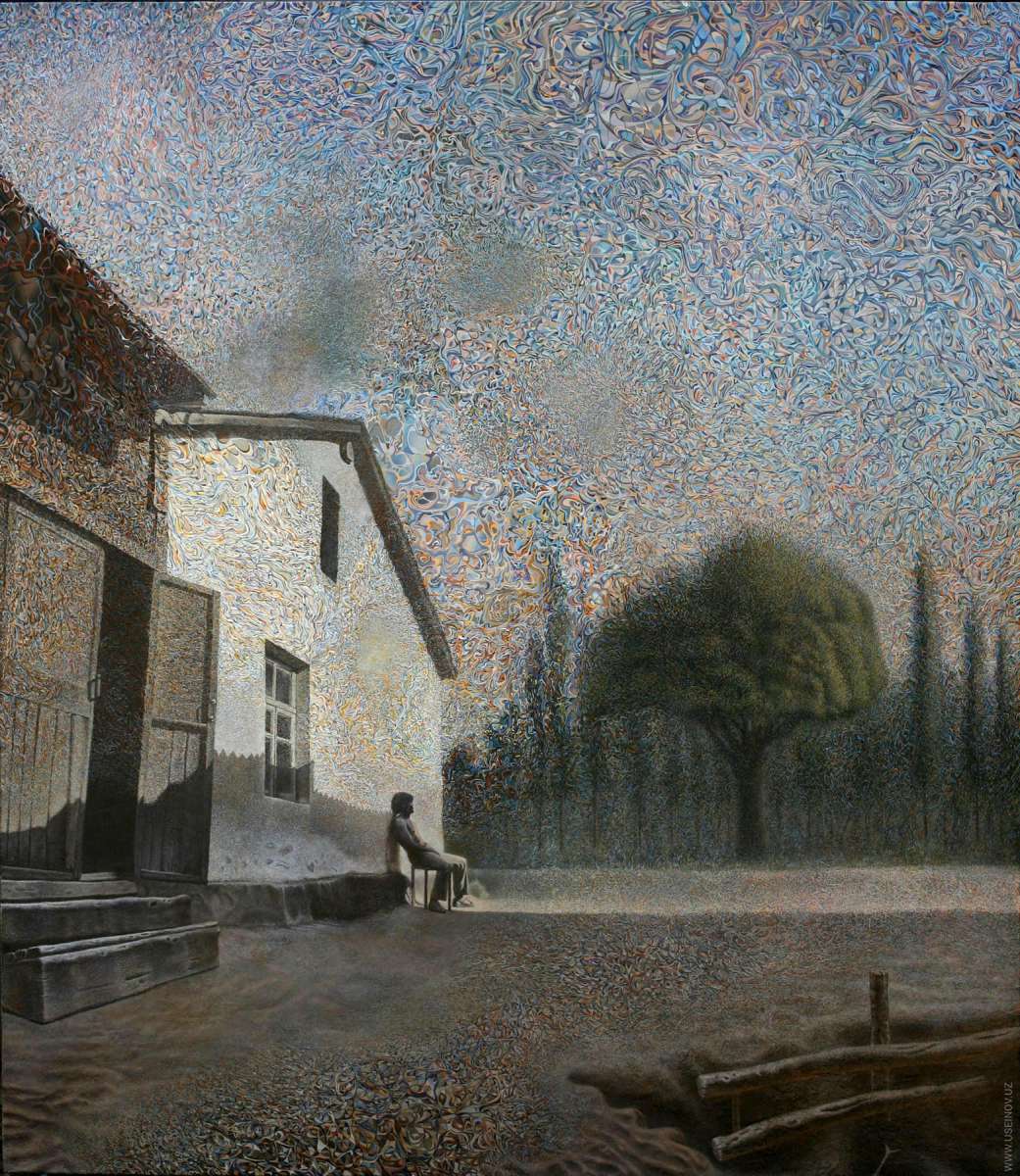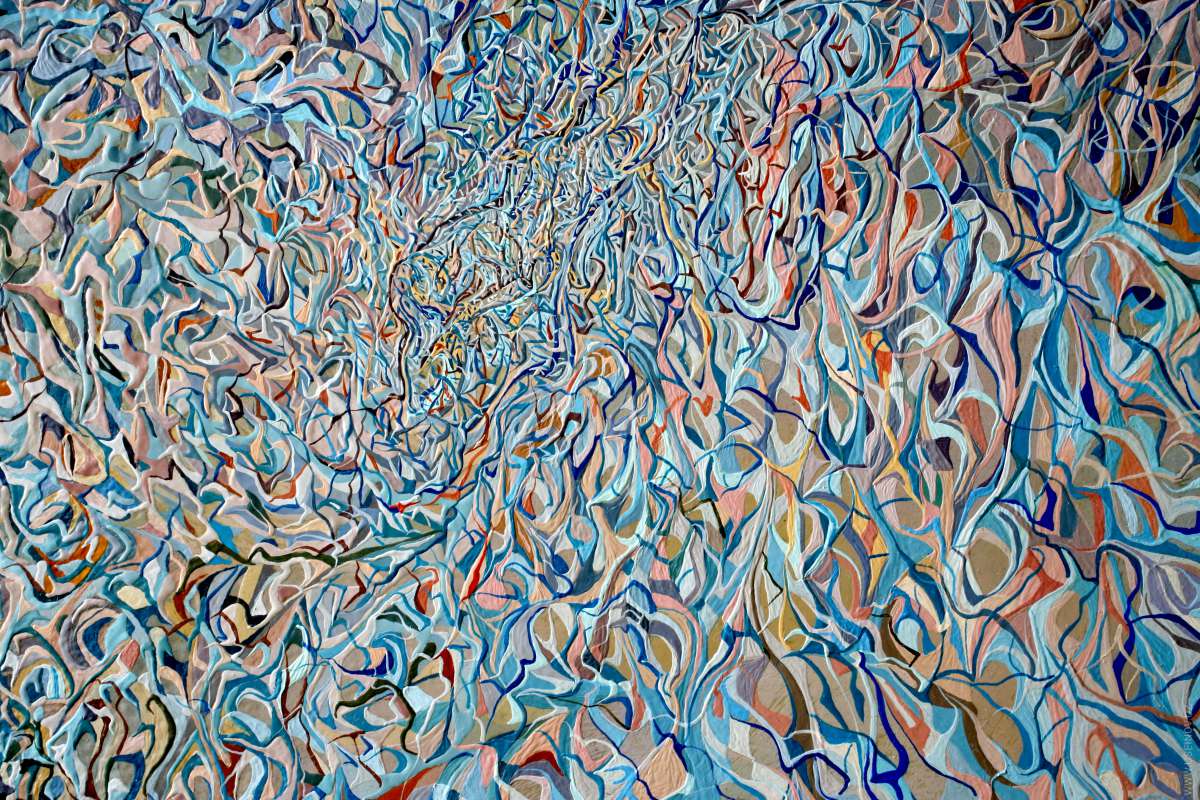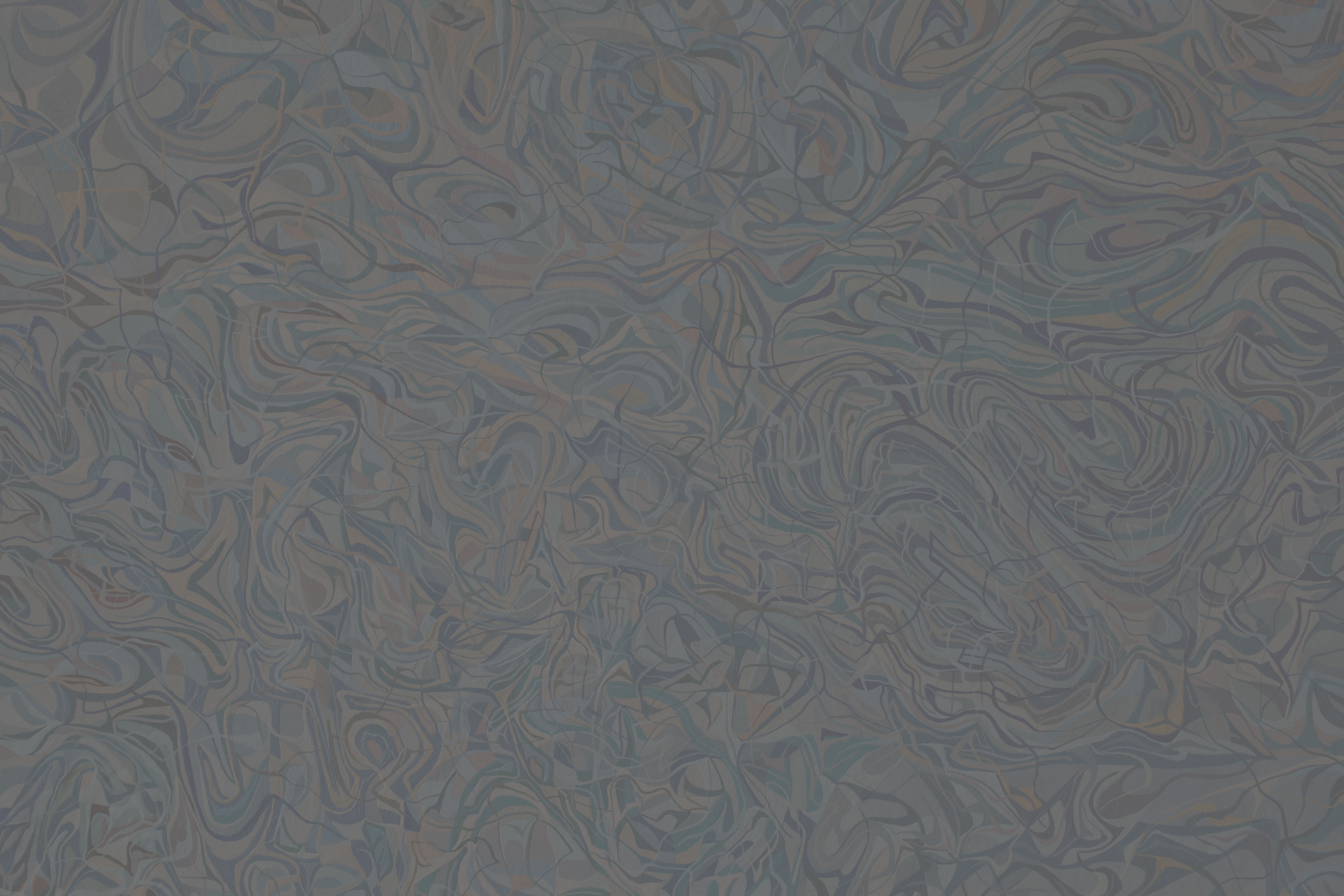Shamshad Abdullaev
ABOUT THE PICTURE BY VYACHESLAV USEINOV
"THE SHADOW OF A NON-EXISTENT HOUSE"

"The shadow of non-existing house".
Technique: canvas, oil. Size: 115x105 cm. Tashkent. 1996-2005
This house - a suburban scar separating a polis from nature, a canon from elements - was in the second half of the last century in Check-Shura, in the old, idyllically-shabby Fergana quarter, on the city outskirts, that is in the narrow area between chaos and order, hierarchy devoid of inviolability and the pedestal of valuations, in the solid medianness where you won’t swindle (to notice and clarify such a stalemate means to take off covers from a caesura and reveal the gap as an urgency)
The artist took years, eleven years (1995 to 2006) to show up on the canvas the persistence of this gap detailed to the faded in the summer heat diversely-faced grains of sand and imponderable, meager, topographic grimaces. There is a feeling that the author, in addition to an attempt to give praise to the finally found hereness, has intended to create, through the reality of the neo-realistic landscape, a dreaming-like autobiography, but not his own (as Italo Zvevo would say), to give at the mercy of fixedness some unstoppable-and-viscous scene of the long estrangement inside the acrimonious climatic magma and typically southern, inert-and-deaf acidity generated by uprushes of the solar riot. The picture indeed has likeness to the meridianalistic films of early Rossellini, or Olmi, or Visconti, or De Santis (which we rather liked than valued).
But only - at first glance. Before us we see by no means a character of the exhausted stunted Mezzogiorno sitting on a stool with his eyes closed and seeing in the inner fold of his eyelids the same landscape, we are looking at from the outside. This figure, perhaps, still belongs to our emery suburb and purely to our peripheral History, open to the Court, if it takes place (as Proust believed, art is just a genuine Dies Irae, which, it should be added, does not forgive inaccuracies). What is it – commemoration of the noon, or siesta of the trickster Central Asian hashishistically anemic, depressed faun, or the Sunday rest of a belated Pre-Raphaelite who had got to know cinéma vérité and the June 1989 massacre? It seems that a monotonous prana of the daytime namaz (the sixth or the ninth Abrahamic hour) is gently meandering like a narcotic smoke along the side corridor of the semi-rural yard. Probably nothing can escape the attention of the observer, every smallness is at risk of becoming a bewitching visual center: the catchlight of the door handle, and the crease of the roof temple, and hillocks of disarrayed steps, and islets of speckled atoms, and a throat indent of a swarthy man, touched by the dust of a province. Each point here bodes an incredibly intensive action, deprived of mobility like a black raven "sitting" on a bare branch in the autumn evening: numbness, swollen beneath the skin of its own onslaught and rush to the aimlessness, where a gong will hardly arrive in time of afterlife. In this oecumene, each sunlit milligram, from nadir to sierozemic terra firma, curls up into the needle's-eye-sized slot allowing only camels of unbribable calmness to pass to the throne of the Millennial kingdom. Light is blazing from right to left and condensing is the stinging hot wind in which, as is usual, the bitterness of some addressless disadvantagedness is more turbid, it is just in this extreme plasticity of the unfavorable environment and rough heat may begin to dawn a despondency of the surrendered nature and the toreuticity of the anthropocentric, scanty loneliness. In this case, it appears that the irreparable stupor of a cachectic witness of the glowing sky and the jagged semi-desert in front of the all-embracing and blind up-to-the-minuteness bearing news about the honey pulp of the non-existent, about the seemingness of the shores of realism and real guises is unlikely to be run through by the furnace of the vanity of haste. This oneiric episode suggests that the artist has cut an imaginary polyptych across the linen chest into two wings on which he has contrastly distributed the usual, household, survived belongings of viscid omnipresent neutrality (below) and myriads of crumbling strokes of blister-like pointillism and astral formlessness (above). It has resulted in a hint at the outline of a "new angel" (Paul Klee), devoid though of memory, not daring to look over in a stuffy vacuum of historical wind calm (or wind?), falling supinely on the unfleshly plane of his own visionary’s hovering. The first thing that catches your eye is not a filmicity of a tanned body on the left, but a fragment of the right, like a wide hollow, a work-weary gaping lingering in the land from where a long-pillar sinciput of some bony and lean construction strains towards the air. What is this skeleton of triple-barrel architecture coupled with the sign of the abyss? – this is anything: a red rag for an inquiring bull; a futuristic yellow T-shirt for the philistine, many-headed hydra; a provocative maneuver; an ecphrasis; an allusion to the incompleteness of any stay within the visibleness (let’s remember the curtain and a heap of rags hiding something disturbingly overlooked in "Last Tango in Paris"); the halfness of elan vital; a look around in the darkness of any of Orpheus; simply a working pit, from which the waist-deep naked young people extract the clay plates for construction of duvals (clay fencing). Or is it the descent into the Deet? A sheer, cranked passage to the fields of asphodels that was not in time to swim away from under our feet a minute earlier? the excavating omphalos in which the chthonic chamber draws its umbilical cord? And a cross-shaped, wooden barrier rising from the semidarkness - not Tenebrae, not the funeral stretcher of the thirty-three-years-old god - serves, to all appearances, as a support or armoring like a of the earthen wall and loose humus. In fact, for eleven years the artist had reproduced - by the seeds of patient points and gently touches (though what is seen, as the picture is reiterating, is not yet completed by the lasting present) - on the vastness of the canvas the meticulousness of the sublime – one and the same scrupulousness of magnetic emanations of different eras equipped with the citations of tenacious and vague recognitions: macchiaioli, Burne-Jones, de Chirico, Seurat, Alibekov, the only paessagio by Morandi, Asher, Hockney, Edward Hopper, Pollock. Such a dotty mossiness has been grafted to the canvas by a porous thoroughness - with the same irresistible stickiness that compels us to become attached to the chimerical this-sidedness and not to leave it not for the benefit of ourselves. In principle, in this hypnotic l lassitude of the settled thingness, in this diplomatic encouraging of the figurative common sense is hidden, in fact, a subversion against the cinematographic arrogance. What is usually unnoticeable (or what is in advance doomed to failure and crash), - a corner of seclusion, - is suddenly put up for show here, and an unpretentious "someone" with no view and grandeur is pressed into the niche of visualization forming a narrative out. In the humble posture of a sitting man, there is a hint of a background of earthly captivity in fierce detachment of the close impersonal, in the dusty to eardrums swollen swooning. The position of his body seems to issue a solicitation for immobility or, rather, for the healing disappearance in which you are invulnerable and protected by your effacement. It is quite possible that this man having no immunity to the symptoms of backbreakingness is paralyzed by his wasteful embeddedness in the time-urgent tetanus, in which through a dense sultry obscurity pulses as an outline drawing of even the whole lifetime of this haggard stranger. Just fatigue is the only thing that distinguishes him from the dead who do not get tired. But granular curls on the upper background , whirling pollen-like as if radiate the promise of soon deliverance – once the knot gets untied and the delusion of "dim glass" dissipates. In addition, the keenness of opplotentes in "The Shadows of a Non-Existent House", muscae volitantes, scattered with a tip of the alert brush in an empty vacation scorching heat adds, to put it mildly, all but pre-sinful non-duality and authenticity of creature’s congelation devoid of life perspective and thrown off into a blind alley of somnambulistic care and mothering amnesia. To top it all, " The Shadow of a Non-Existent House" is left on the sidelines by a forty-year-old observer kneeling down like the operator Yasujiro Ozu – far from the context, not in the thick of the spread of a certain correctness, of its instantaneous readout by the reflexing interestingness, but in an increasing tension of crestfallenness and rejectedness.
This state of damage (no one’s and entirely ours) behaves as if it is associated with accurate monumentality of Poussin’s classicism stained here and there with cadaveric spots of the Baroque. In these lands, lawlessness mimics a permissible outrage and the balance between the mass (which is non-existent) and the fulcrum (which is non-existent).In these circumstances, the assignment of the demiurgic will is to unmistakably get into the zero fluidity of the neutral, which does not tally with the intrigue of the further with the comfort of the sparingly unknown future and offers something more mature and kingly: complete nonexistence. Thereby, in the atmosphere of exhaustiveness of any reasons, culminations and needlessness of a finale (“but the total is not the entire limit," Emily Dickinson), the care of honest optics and stoicism is reduced to not losing the sight of only long-perished details in which the mirage pretends to be the purest tangibility of proportions and the genuineness foaming with warmth. Obsession with confidence in this visual play by Vyacheslav Useinov is achieved (to spite phenomena which disintegrate since they consist of parts) due to the absurd unselfishness to the nuances and reverence before the oasis of the latent decaying of supposedly obvious details that, ideally, somehow conceal the privileged position of the deep pool and the accomplished annihilation . In short, the world has come to an end, but there remained a not-counting-on-anything plasticity of external immobility and external movements of the flung-open surface, there remained a win-win confusion of the unpredictable spontaneity and the unceasingness giving, in recital of signs of accidentality and scraps of unintentionality, something non-symbolically visible in the changeable nimbleness of any earth area: crumpled sandals (or gym shoes, or ashy galoshes on gnarled bare feet); a light cut between male nipples, between umber and the full blaze of the sun; a shred of the anthracite-dark coolness, trying to outwit in credibility the door threshold like a material evidence of hallucination; an oval cut of the Andrew Wyeth’s log shading the attic gullet by the curtailed canopy; a wood carcass, splashed with foliage hiding the buzzards’ nests; the traumatization fortress of a suburban outcast; the last kasb of your rootlessness burnt down to ashen dilapidation, mummy of the bleached in the pestilential flame long wall citadel from the second, wandering part of the "Nazarene"; a hazy opening behind the plywood, rectangular fold, an epigonically and geometrically distinct cast of the yard crypt amorphism; jagged shadows of the already off screen demolished housing, crawling on the scaling off façades of the neighboring house like a snaky phantom and ragged ephemeris squashed by Gothic architecture; a somnolent head rotation authorized by the guardian angel or a bearer of the midday lethargy; the tachist dappling of celestial abstraction that resembles a giant, melted by the sun in Saratan, in in the height of summer, over Lombardy poplars, over the primacy of sepia in the crystalline maturity of the figurative fruit, in the ashes of larval seeds; in the monochrome of fly’s repeats, in the flakes of swarming look-alikes. In general, this picture is painted with such maniacal respect for flickering-and- lancinating impoverishment of the marginal microcosm that it is not difficult to forget it immediately. In addition, the neighborhood dust is dispelled over and above and is so abundant that unconsciousness can be woven from it: "where once towered a real house, now the image is yearning, the purest figment", Rilke, the Seventh Duino Elegy.

